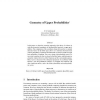Free Online Productivity Tools
i2Speak
i2Symbol
i2OCR
iTex2Img
iWeb2Print
iWeb2Shot
i2Type
iPdf2Split
iPdf2Merge
i2Bopomofo
i2Arabic
i2Style
i2Image
i2PDF
iLatex2Rtf
Sci2ools
ISIPTA
2003
IEEE
2003
IEEE
Geometry of Upper Probabilities
In this paper we adopt the geometric approach to the theory of evidence to study the geometric counterparts of the plausibility functions, or upper probabilities. The computation of the coordinate change between the two natural reference frames in the belief space allows us to introduce the dual notion of basic plausibility assignment and understand its relation with the classical basic probability assignment. The convex shape of the plausibility space Π is recovered in analogy to what was done for the belief space, and the pointwise geometric relation between a belief function and the corresponding plausibility vector is discussed. The orthogonal projection of an arbitrary belief function s onto the probabilistic subspace is computed and compared with other significant entities, such as the relative plausibility and mean probability vectors. Keywords theory of evidence, belief space, basic plausibility assignment, plausibility space, orthogonal projection
| Added | 04 Jul 2010 |
| Updated | 04 Jul 2010 |
| Type | Conference |
| Year | 2003 |
| Where | ISIPTA |
| Authors | Fabio Cuzzolin |
Comments (0)

